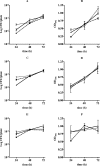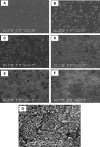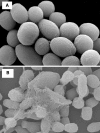Biofilm formation by the emerging fungal pathogen Trichosporon asahii: development, architecture, and antifungal resistance
- PMID: 17005804
- PMCID: PMC1610057
- DOI: 10.1128/AAC.00556-06
Biofilm formation by the emerging fungal pathogen Trichosporon asahii: development, architecture, and antifungal resistance
Abstract
Trichosporon asahii is the most common cause of fatal disseminated trichosporonosis, frequently associated with indwelling medical devices. Despite the use of antifungal drugs to treat trichosporonosis, infection is often persistent and is associated with high mortality. This drove our interest in evaluating the capability of T. asahii to form a biofilm on biomaterial-representative polystyrene surfaces through the development and optimization of a reproducible T. asahii-associated biofilm model. Time course analyses of viable counts and a formazan salt reduction assay, as well as microscopy studies, revealed that biofilm formation by T. asahii occurred in an organized fashion through four distinct developmental phases: initial adherence of yeast cells (0 to 2 h), germination and microcolony formation (2 to 4 h), filamentation (4 to 6 h), and proliferation and maturation (24 to 72 h). Scanning electron microscopy and confocal scanning laser microscopy revealed that mature T. asahii biofilms (72-h) displayed a complex, heterogeneous three-dimensional structure, consisting of a dense network of metabolically active yeast cells and hyphal elements completely embedded within exopolymeric material. Antifungal susceptibility testing demonstrated a remarkable rise in the MICs of sessile T. asahii cells against clinically used amphotericin B, caspofungin, voriconazole, and fluconazole compared to their planktonic counterparts. In particular, T. asahii biofilms were up to 16,000 times more resistant to voriconazole, the most active agent against planktonic cells (MIC, 0.06 microg/ml). Our results suggest that the ability of T. asahii to form a biofilm may be a major factor in determining persistence of the infection in spite of in vitro susceptibility of clinical isolates.
Figures





Similar articles
-
Multiple species of Trichosporon produce biofilms highly resistant to triazoles and amphotericin B.PLoS One. 2014 Oct 31;9(10):e109553. doi: 10.1371/journal.pone.0109553. eCollection 2014. PLoS One. 2014. PMID: 25360765 Free PMC article.
-
Trichosporon asahii causing nosocomial urinary tract infections in intensive care unit patients: genotypes, virulence factors and antifungal susceptibility testing.J Med Microbiol. 2012 Dec;61(Pt 12):1750-1757. doi: 10.1099/jmm.0.049817-0. Epub 2012 Sep 6. J Med Microbiol. 2012. PMID: 22956749
-
In Vitro Antifungal Activity of Sertraline and Synergistic Effects in Combination with Antifungal Drugs against Planktonic Forms and Biofilms of Clinical Trichosporon asahii Isolates.PLoS One. 2016 Dec 8;11(12):e0167903. doi: 10.1371/journal.pone.0167903. eCollection 2016. PLoS One. 2016. PMID: 27930704 Free PMC article.
-
[Antifungal susceptibility and drug-resistant mechanism of Trichosporon].Med Mycol J. 2015;56(4):J123-8. doi: 10.3314/mmj.56.J123. Med Mycol J. 2015. PMID: 26617108 Review. Japanese.
-
Trichosporon asahii infection presenting as chronic meningo-ventriculitis and intra ventricular fungal ball: a case report and literature review.Mycoses. 2015 Feb;58(2):99-103. doi: 10.1111/myc.12282. Epub 2015 Jan 15. Mycoses. 2015. PMID: 25590228 Review.
Cited by
-
Biofilm formation by Pneumocystis spp.Eukaryot Cell. 2009 Feb;8(2):197-206. doi: 10.1128/EC.00202-08. Epub 2008 Sep 26. Eukaryot Cell. 2009. PMID: 18820078 Free PMC article.
-
The Hidden Fortress: A Comprehensive Review of Fungal Biofilms with Emphasis on Cryptococcus neoformans.J Fungi (Basel). 2025 Mar 19;11(3):236. doi: 10.3390/jof11030236. J Fungi (Basel). 2025. PMID: 40137272 Free PMC article. Review.
-
Exploring the female genital tract mycobiome in young South African women using metaproteomics.Microbiome. 2025 Mar 19;13(1):76. doi: 10.1186/s40168-025-02066-1. Microbiome. 2025. PMID: 40108637 Free PMC article.
-
In Vitro Interactions between Non-Steroidal Anti-Inflammatory Drugs and Antifungal Agents against Planktonic and Biofilm Forms of Trichosporon asahii.PLoS One. 2016 Jun 8;11(6):e0157047. doi: 10.1371/journal.pone.0157047. eCollection 2016. PLoS One. 2016. PMID: 27275608 Free PMC article.
-
Effect of resveratrol and Regrapex-R-forte on Trichosporon cutaneum biofilm.Folia Microbiol (Praha). 2019 Jan;64(1):73-81. doi: 10.1007/s12223-018-0633-0. Epub 2018 Jul 30. Folia Microbiol (Praha). 2019. PMID: 30062620
References
-
- Abdala, E., R. I. Lopes, C. N. Chaves, E. M. Heins-Vaccari, and M. A. Shikanai-Yasuda. 2005. Trichosporon asahii fatal infection in a non-neutropenic patient after orthotopic liver transplantation. Transpl. Infect. Dis. 7:162-165. - PubMed
-
- Armitage, G. C. 2004. Basic features of biofilms—why are they difficult therapeutic targets? Ann. R. Australas. Coll. Dent. Surg. 17:30-34. - PubMed
-
- Chandra, J., G. Zhou, and M. A. Ghannoum. 2005. Fungal biofilms and antimycotics. Curr. Drug Targets 6:887-894. - PubMed
-
- Chowdhary, A., S. Ahmad, Z. U. Khan, D. C. Doval, and H. S. Randhawa. 2004. Trichosporon asahii as an emerging etiologic agent of disseminated trichosporonosis: a case report and an update. Ind. J. Med. Microbiol. 22:16-22. - PubMed
Publication types
MeSH terms
Substances
LinkOut - more resources
Full Text Sources

